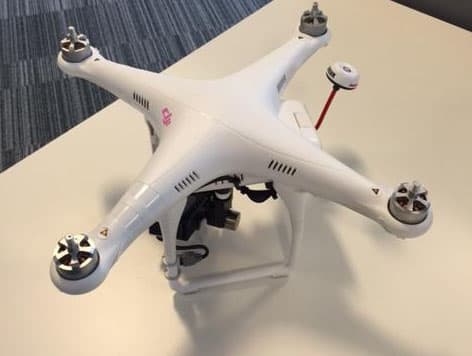Photo credit: Greater Manchester Police
CLICK HERE TO READ THE UK LAWS ON DRONE USE
Police arrested the 41-year-old after receiving reports of a drone flying over the East Stand of the Etihad Stadium during a match between Manchester City and Tottenham Hotspur on 18 October.
The man, from the Nottingham area, was arrested at a nearby Asda car park and bailed for eight weeks pending further enquiries.
Chief Inspector Chris Hill said: ‘The drones could pose a threat to crowd safety and potentially cause alarm in crowded areas.
‘Even small drones can weigh up to 8kg and could cause damage or injury if they fall from height.
‘Thankfully, no one was hurt.’
He added: ‘People may see this as a minor offence, but it is a breach of the Air Navigation Order, which is prosecuted by the Civil Aviation Authority.’
It has since been reported that the drone may have had a camera attached, in order to take overhead shots of the stadium.
So, what are the aviation rules?
This was explored by Amateur Photographer last month.
To recap, photographers who plan to use a small unmanned aircraft (20kg or less) for commercial purposes require permission from the Civil Aviation Authority (CAA).
But enthusiasts don’t need permission from the CAA to operate a drone – unless they plan to fly it close to people or objects.
Specifically, this means flights over or within 150 metres of any congested area; over or within 150 metres of an organised open-air assembly of more than 1,000 persons; or flights within 50 metres of any person, vessel, vehicle or structure not under the control of the pilot.
The aircraft must be kept within visual line of sight of the operator.
No specific permission from the CAA is required for a landowner to operate a drone over private land, subject to these safety distance rules.
But permission of the landowner would be required if an unmanned aircraft is taking off and landing from private land.
Flights are restricted to 400 feet above surface level, unless appropriate air traffic control unit permission is obtained.
Last week, photo rights lawyer Charles Swan told Amateur Photographer that new laws may be required if drone use becomes widespread in the UK.
He said: ‘Whether current privacy, harassment, trespass and other laws in the UK are adequate to deal with disputes involving drones remains to be seen, as and when the use of drones becomes more widespread in the UK.
‘If it becomes a major issue, there may need to be specific legislation.’
The Information Commissioner’s Office (ICO) is the UK’s privacy watchdog.
The ICO treats photos as data, but ‘domestic’ use of drone-captured images is completely exempt from the Data Protection Act.
Journalism, literature and art are also exempt from the Act, under Section 32 of the 1998 legislation.
Unless exempt, drone users must comply with the Act if the images are for business use and the people pictured are identifiable. Data protection rules give people in such images a right to ask for their photos to be deleted, if they have not given consent beforehand.
And, if subject to data protection rules, drone operators must alert people that they plan to use the device for such purposes in a given area.







